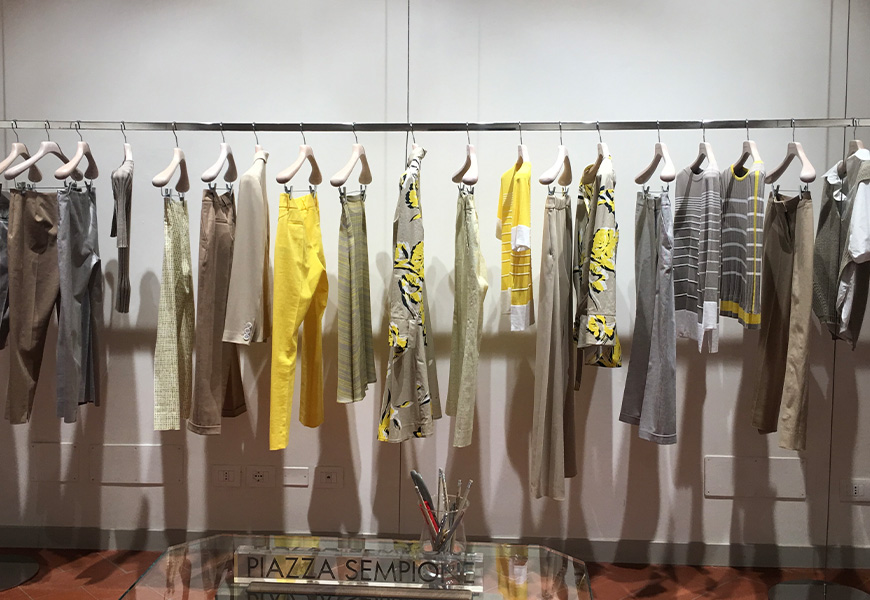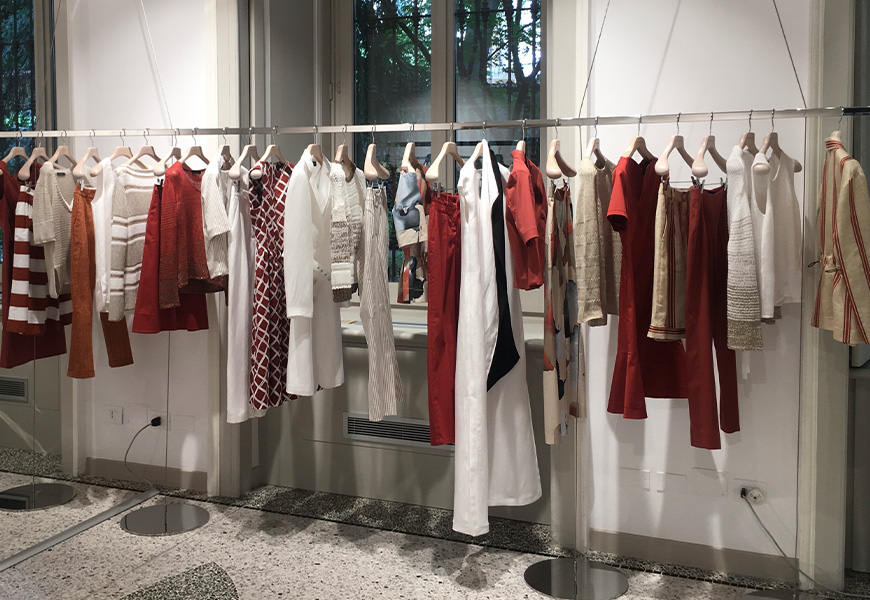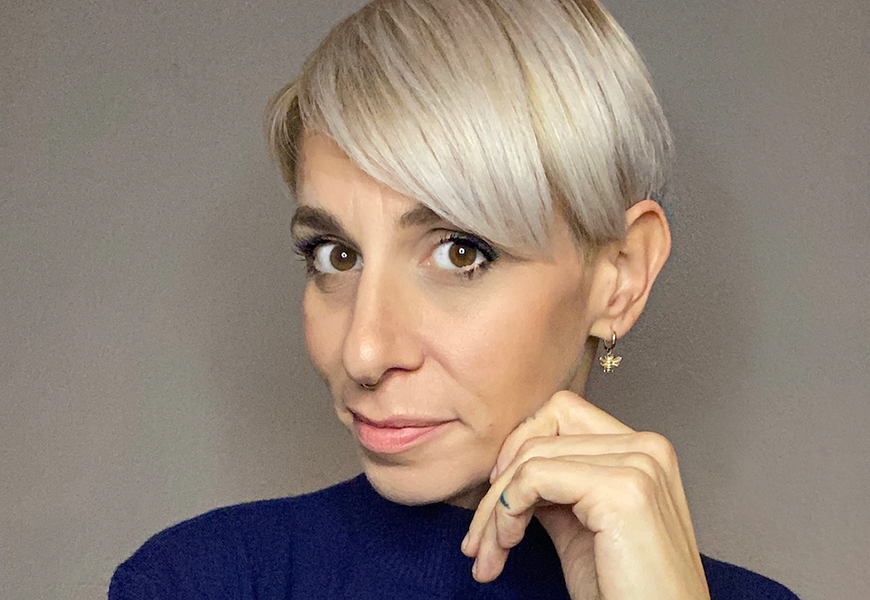The art of the visual merchandiser: interview with Marica Gigante
Coat hangers, clothes stands and shoe and clothes racks are more than mere practical objects. They also play an important role in displaying the merchandise, in the most functional and sophisticated way. An original window display can easily attract attention, but it’s the details that make the difference, and dressing clothes hangers with care and consideration is an essential aspect of visual merchandising. Nobody is more aware of this than Marica Gigante, a true expert in visual merchandising who knows exactly what her skills can do to increase retailers’ sales, now more than ever, when customers want to fully enjoy and be captivated by the shopping experience. Marica managed to find a little time between her workshops, master classes, university lectures and consultancy commitments to tell us about her approach to creativity, design and planning.
Marica Gigante tells us what it means to be a visual merchandiser
Q: Let’s start from the beginning: how did you become a visual merchandiser with 20,000 Instagram followers?
MG: I started around ten years ago, posting YouTube videos using and commenting on the photographs I took of the window displays of the major brand stores, to assess how effective and attractive they were and how consistent they were with the brand message. I must have hit the target and identified the need for someone capable of expressing clear and logical opinions and explaining the principles of marketing in the retail industry. Before long, I was receiving requests for assistance from famous brand names and stores which wanted to improve the way in which they displayed their products and learn new techniques, and retailers’ associations and universities also expressed an interest. It’s a complex process, which is constantly evolving, especially as we are always dealing with different types of outlet, in terms of format, style, lighting and products, all of which are equally important and must be given due consideration.
Q: Would you call it, an evolution of the more familiar figure of the window dresser?
MG: Not at all. They’re two completely different things, even though they’re frequently confused. There are very few people out there who are equally comfortable in both of those roles. The finest window dressers operate in a less complex dimension, where the variables are usually reduced to the minimum. What they do is definitely an art form, while our work is a discipline in which creativity certainly plays a role but is not the only factor. Visual merchandising could be described as a strategic process that has to satisfy a series of requirements, both economic and otherwise. The use of the space within a store must be assessed with great care and follow rigorous guidelines, at least when we’re dealing with the major international brands. It was the Americans who first introduced the brand concept inside the physical store. In Italy, it took longer for this process to take off. One of the first to adopt it here was Ettore Sottsass, in the Esprit and Fiorucci stores in the eighties, but it’s still relatively new here in Italy. I like to think of the visual merchandiser as a kind of silent salesperson who creates the perfect scenario for every object on sale in a setting where the customer feels fully at ease.
Store displays: props and clothes hangers between change and design
Q: How have things changed in the last 40 years?
MG: Everything has changed. When I started out in this business there was no such thing as a course on visual merchandising. You learned on the job. When I was young, I worked as a garment folder in the Ralph Lauren showroom, where I folded literally thousands of polo sweaters – a technique I will never forget! – while studying marketing and design in my spare time. Today’s young people are luckier, they can choose from a wide range of university and post-graduate courses. Having said that, however, there’s no real replacement for direct on the job experience. And the same can be said for curiosity: you have to keep your eyes open all the time, be out and about, look, touch and compare. That’s what I do every two weeks, on my tour around display windows and supermarkets too, where I always learn a lot and get new ideas for my projects.
Q: What does a visual merchandising project involve?
MG: The projects follow, or better still, they anticipate the seasons. One of the most important ways in which brands, especially fashion brands, present their collections is to create veritable shows, which don’t just get the onlookers involved, but amaze and astound them. The planning, production and creation of these events is time consuming and requires the skills of different specialists. And that explains why the first and, even more, the second wave of the pandemic threw a spanner into the usually smooth-running works of the brand stores: having been planned well in advance, some Christmas window displays seemed not to take into consideration what was happening in the outside world. But in the next few months, we will start to see window displays designed to reflect the historic period we’re living through at the moment. The smaller brands, the small retail chains and the independent stores can be more flexible and are able to change their displays to keep pace with the moment in time.
Q: So the pandemic has changed everything…
MG: Yes, that was inevitable. There was an immediate switchover to online buying, where the approach is different, but we must remain faithful to the tone of voice of the brand and make sure the purchasing experience continues to be in line with customer expectations. Many brands have understood the type of change that’s taking place, and have been able to adapt. One example is Dior Home Perfumes, which set up a virtual store where you can browse online. More are now following on, and the buying methods are becoming simpler. Clearly, the human contact is altogether a different experience…. digital is the “angel/devil” of shopping, which we must now take into account to make the most of new opportunities, but it isn’t the only solution.
Obviously, the pandemic has led to major changes in the physical stores, but as many as 80% of those entering the stores at the present time actually make a purchase. Of course, only a very small number of people are prepared to visit the stores at the moment, but those that do, come into the shops with the intention of buying something.


Preparations by Marica A. Gigante for the client Piazza Sempione, showroom via S. Maurilio 2019
More than a visual experience: it’s the details that make the difference
Q: Let’s talk about what’s inside the store…
MG: While the window display has to “shout” to attract the customers’ attention, the interiors of stores are becoming more sober than ever. But, that doesn’t mean that working on the internal display is any easier! Every object has to be visible and nothing must clash. Each article must be displayed to its best and take advantage of the ideal lighting conditions. Dummies, props, posters, shelves and display materials are all designed with great care to ensure they’re in line with, or even better, able to expand the brand message and language. They must be functional, attractive and effective.
All this might seem obvious, but not everybody has learned the lesson. I often step into exclusive boutiques only to be confronted with a whole series of beginners’ errors. One of the most frequent mistakes, unfortunately, is the incorrect use of clothes hangers and racks. Not enough care is taken over the size, thickness or style of clothes hangers, which means that some garments just dangle lifelessly, others show the marks of the hangers, while in some cases so many garments are crammed on the same rack that it becomes impossible to work them loose. There still isn’t enough attention to detail, which is such a pity.
Q: What can we expect after Covid-19?
MG: I imagine a kind of retail renaissance based on a wholly human experience, a way of moving through physical space in which authenticity is what matters, and we see the return of interpersonal relations.
Q: Have you a message for young people who’d like to start a career in visual merchandising?
MG: You have to really love what you do, and to grow professionally you always have to ask yourself “why”? Never take anything for granted, keep looking, and never stop being curious.


